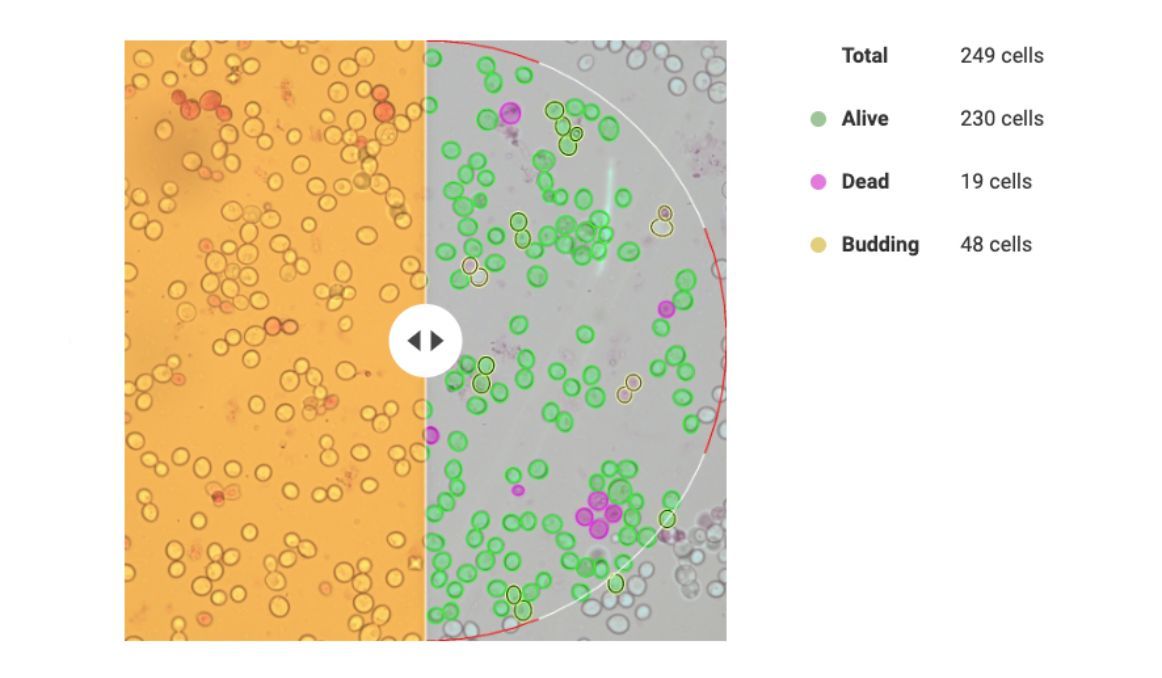Yeast Viability
So now you know what the viability is. How can you use this data?
Just as important as yeast cell concentration, viability, typically expressed as a percentage, stands for the proportion of live cells within the analyzed cell population. So, for example, a viability of 85% indicates the fact that 85% of the yeast cells in the sample you’re analyzing are alive, while 15% are dead.
With Oculyze you will see the viability expressed as a percentage, but you will also see exactly how many yeast cells are alive and how many are dead.

Yeast concentration and viability go hand in hand during the pitching process. You may have the right yeast cell concentration, but if the viability is low, there is a high chance you will still end up with fermentation issues, or, at the very least, you will not be able to achieve product consistency. Basically, pitching a low viability yeast will have the same effects as underpitching. The explanation for that is as straightforward as they come: only living cells can ferment the wort (or must), so dead yeast cells will not metabolize the sugars. So if you’re unknowingly pitching a low viability yeast, when pitching without factoring in the viability, you’re actually pitching less than you’ve intended.
Normally, the recommendation, if you have a low viability yeast, is to pitch a higher amount of yeast. However, it is never a good idea to pitch too many dead cells, as these come with a high risk of yeast autolysis (the rupturing of the yeast cell and the leaking of undesirable substances in the beer or wine, ultimately leading to off-flavors). That’s why it’s always recommended to work with yeast that has optimal viability.
Now, ideally, the viability should be at least 95%. However, this depends on the yeast strain and your process – you may feel comfortable with and even get the desired results by working with lower viabilities, although for proper fermentations you normally need a viability of at least 85%. So once you know your yeast cell concentration and your viability, you can have a very precise pitching process (basically pitch the same amount of yeast every time), which will ensure product consistency.
Another thing you can use this data for is to make sure that your yeast provider is making good on their promises. More often than not, while yeast manufacturers guarantee a certain viability for their yeast, by the time you’re ready to pitch it, the viability may be significantly lower than what’s written on the package. Analyzing the yeast’s viability before pitching it ensures that you’re pitching the right amount every time and it may also give you a good indication of whether you’ve chosen the right yeast supplier.
Equally important, if you’re harvesting and repitching your yeast, keeping an eye on the viability is a must. Viability may start to drop after a few generations, so you want to know when it’s time to ditch it and harvest a new batch of yeast. The number of times yeast can be reused can widely vary, depending primarily on the type of strain, the quality of the cropped yeast, and original wort (or must) gravity, so determining the exact number of times a certain strain can be repitched is very important for the quality and consistency of your final products. While typically yeast lasts for 5-8 generations of repitching, there have been reports of lager yeast being reused successfully for up to 20 times. And being able to reuse your yeast efficiently can save you thousands and up to hundreds of thousands of dollars over the course of a year.
Storage conditions may also have a serious impact on yeast viability, so checking the viability of your yeast (either the one you bought from a manufacturer or the one you harvested yourself) from time to time will not only prevent you from using a low viability yeast and potentially ruining an entire batch, but it can also help you put a proper storage protocol in place.
Last but not least, monitoring your yeast viability along the whole fermentation process can give you important insights into how the fermentation is going and help you deal with any issues before they even arise, and prevent any sudden changes in flavor, aroma, and fermentation performance. Any sudden drop in yeast viability is an indication that something went wrong with that fermentation and that measures need to be taken to bring it back on track.
Not our customer yet? Join the hundreds of brewers from all around the world using the Smartest Automated Yeast Cell Counter!
Request a Free Demo Account today and experience firsthand how Oculyze can take your brewery to the next level!